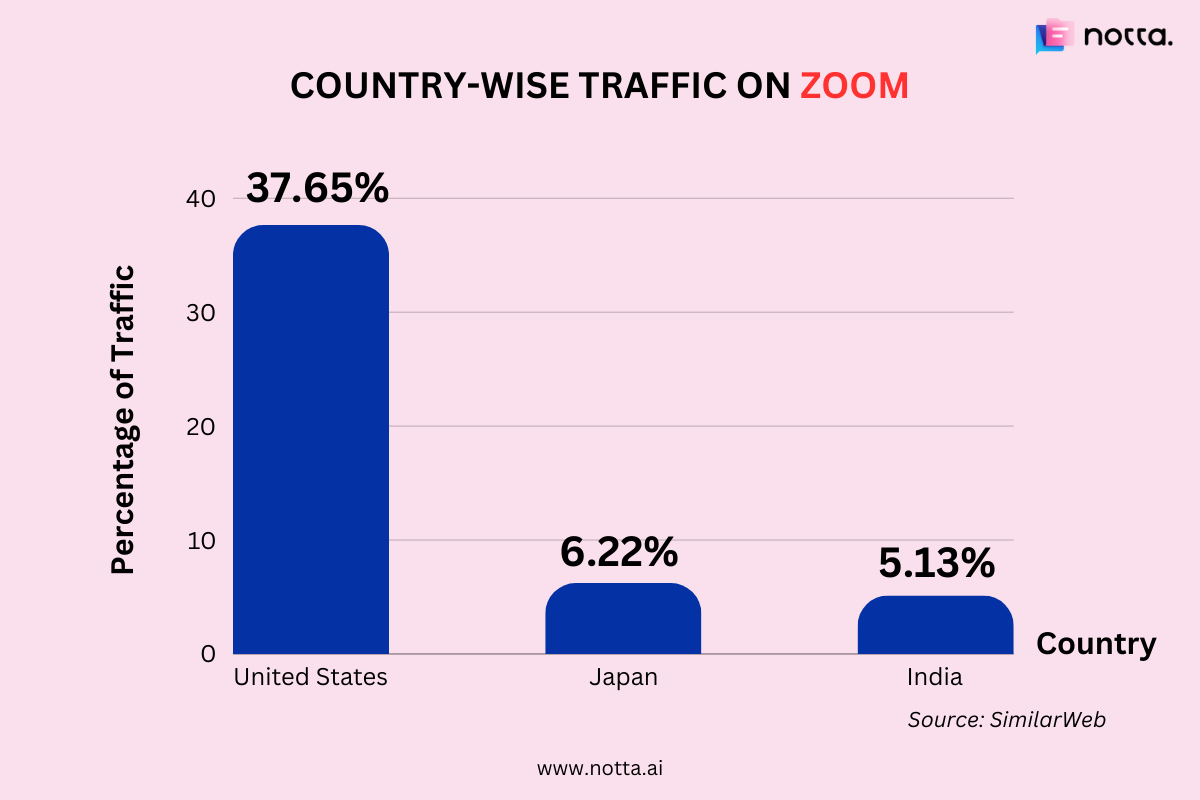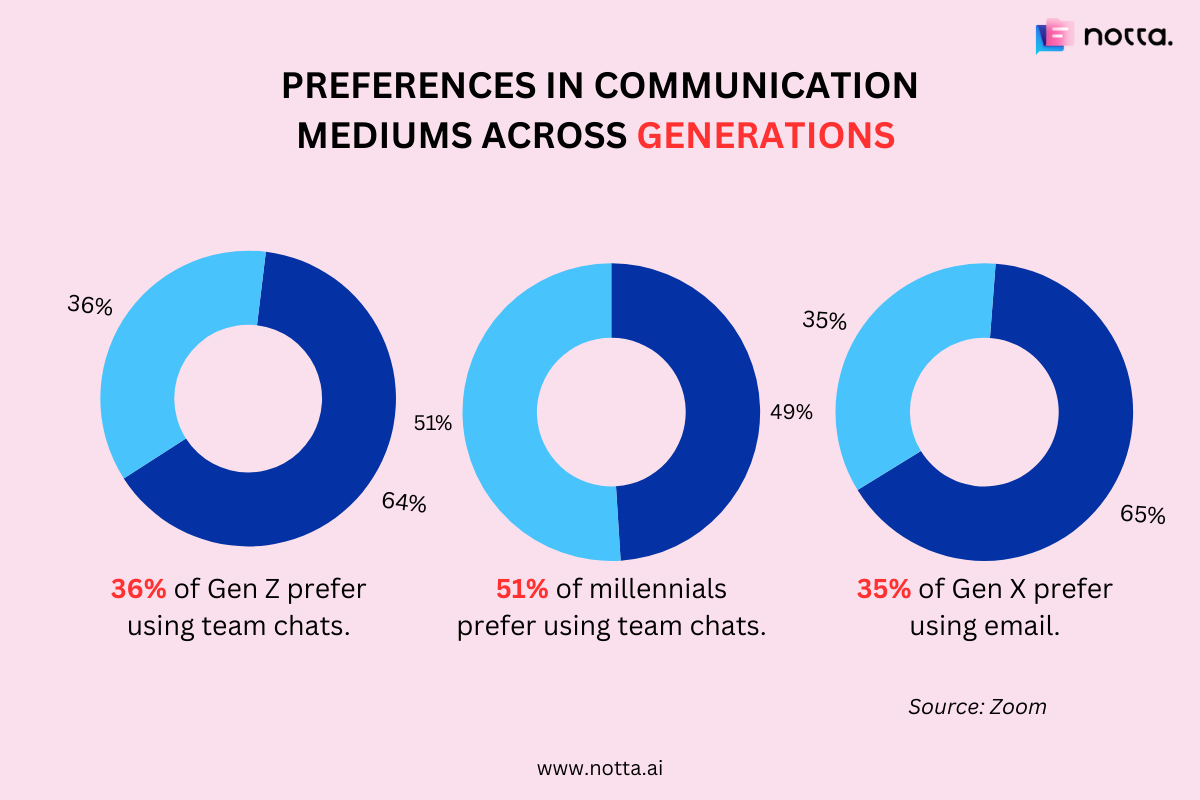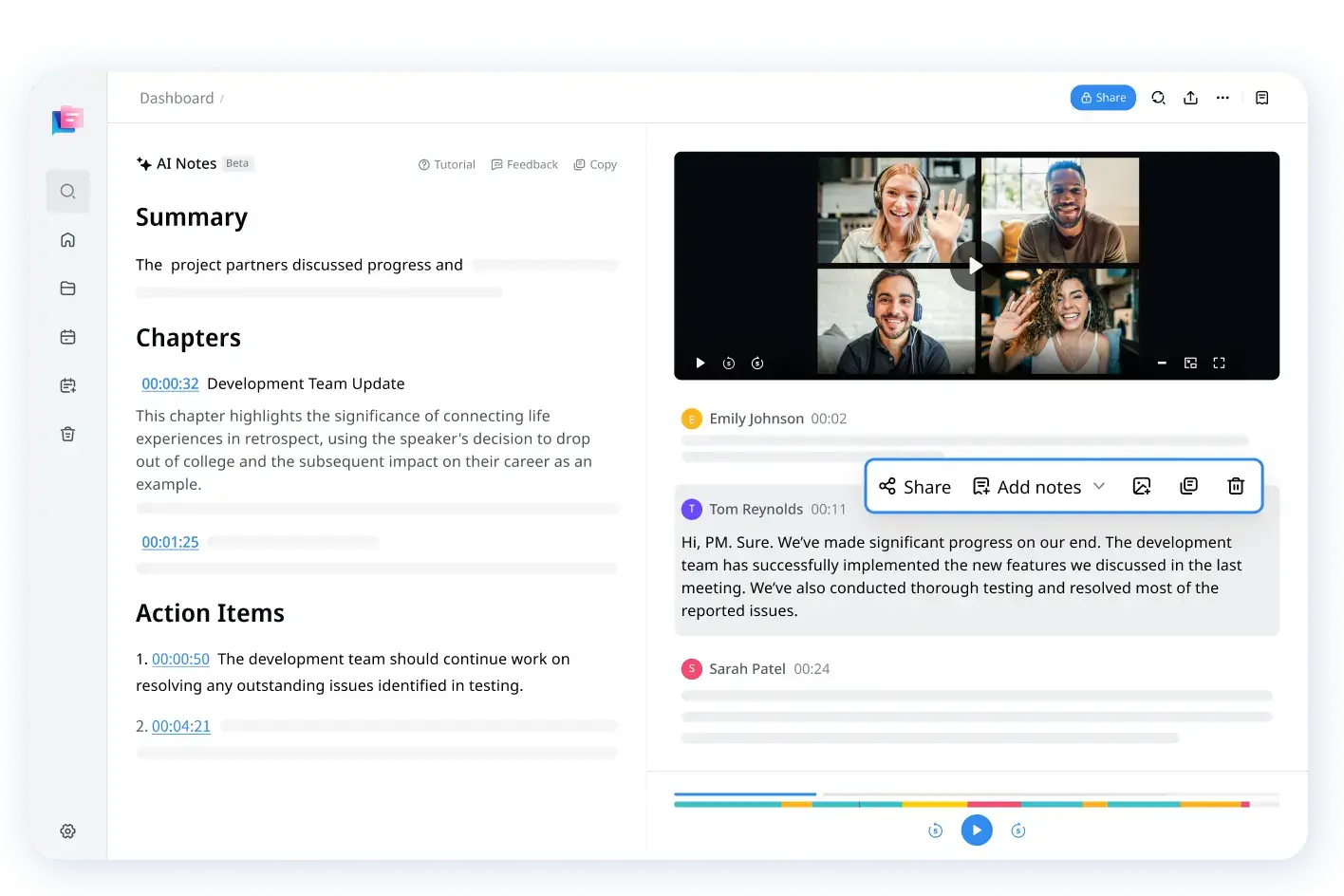
50+ Zoom Statistics in 2025: Users, Growth, Employees
Unlock the power of AI — Notta's meeting assistant records, transcribes and summarizes meeting minutes with one click.
Back when Zoom was introduced in 2020, it became synonymous with video conferencing. Today, it remains one of the most popular video conferencing platforms and is used by organizations of all sizes worldwide.
I’ve used Zoom for a few years now, and in this guide, I take you through some of the most important Zoom statistics to give you an insight into its user base, growth over the years, and its employees.
Zoom stats: Top picks
Here are some of my top picks from this set of statistics on Zoom and its usage, revenue, and the organization itself:
According to Zoom’s Q3 FY2024 Earnings Report, there are a total of 7 million paid Zoom phone seats — an increase from the 4 million seats sold in July 2022.
Zoom’s annual revenue for 2024 has been valued at $4.527 billion, which is an increase of 3.06% from 2023.
The average length of a meeting on Zoom is 52 minutes.
Zoom reached its peak in terms of market capitalization in October 2020 at a whopping $139 billion during the height of remote work globally.
Zoom surpassed 5.5 million seats on mobile by the end of FY23.
As of January 31, 2024, the total number of full-time employees fell to 7,420 from 8,484 as of January 31, 2023.
Zoom user statistics
Zoom was among the first video conferencing platforms to take center stage during the COVID-19 pandemic. Since then, its user base has grown monumentally, and the tool is now used worldwide across a range of industries and organization sizes. The first section takes you through some key Zoom user statistics and provides insight into the platform’s user base and demographic details.
How many people use Zoom?
Zoom has a massive global user base, and this is evidenced in the organization’s financial earnings reports. This user base varies across demographics, highlighting the wide reach of the platform’s penetration across markets. Check out some key Zoom user statistics below.
According to Zoom’s Q3 FY2024 Earnings Report, there are a total of 7 million paid Zoom phone seats. This is an increase from the 4 million seats sold in July 2022.
The highest proportion of traffic on Zoom comes from the United States, at 37.65% as of June 2024. This is followed by Japan at 6.22% and India in third place at 5.13%.

Zoom active users
Zoom has the highest user base when compared to various other video conferencing platforms. This is largely a result of its effective marketing during its introduction during the pandemic and the platform’s reliability for organizations of all kinds and scales. Besides organizations, Zoom is also widely used in a personal capacity for those who want to connect with their friends and family. According to one of Zoom’s blogs, the video conferencing platform has about 200 million meeting participants.
Demographics of Zoom users
Zoom’s user demographics vary across age, location, and how they access the platform in itself. This section highlights some key statistics that break down the variety of demographic elements across Zoom’s user base.
The highest percentage of Zoom’s user base falls within the age bracket of 25 to 34 years at 29.9%.
The second-highest percentage of Zoom’s user base is between the ages of 35 and 44, at 21.67%.
The US, Japan, India, Canada, and the UK account for more than 50% of Zoom’s net revenue. These countries also have the highest share of users of this video conferencing platform globally.
Zoom’s website received 11.2 million visits via desktop and mobile in June 2024 alone.
Zoom’s annual revenue for 2024 has been valued at $4.527 billion, which is an increase of 3.06% from 2023.
As of the third quarter of FY21, Zoom hosted a total of 3.3 trillion meeting minutes a year.
Zoom growth during the pandemic
Zoom’s growth during the COVID-19 pandemic was exponential. It has been one of the key remote working tools during this period. This section explores some key statistics that highlight this growth over time.
Initial surge in 2020
Zoom’s surge during 2020 was immense. What started off with a presence in two countries soon made its way across continents, with the number of daily active users increasing by the day. The statistics below highlight the pace of Zoom’s growth during the pandemic.
Zoom started with its presence in 2 countries in January 2019, which were the United States and Canada, and by August 2020, it had secured a presence in 43+ countries and territories.
By December 2019, Zoom has about 10 million meeting participants. By March 2020, this number shot up to 200 million.
Between November 2020 and November 2021, Zoom was used in 200 countries and territories around the world. The app quickly became synonymous with video conferencing with people using it professionally to connect with their friends and loved ones.
In the same period, Wednesday was the top day for meetings and calls on Zoom, followed by Tuesday. The order flipped later in 2022, with Tuesday being the busiest day of the week.
Zoom reached its peak in terms of market capitalization in October 2020 at a whopping $139 billion. This was during the height of the remote work scenario globally.
Sustained growth post-pandemic
Even after the pandemic, Zoom’s growth continued rising. With remote and hybrid work setups becoming the norm across organizations, the reliance on video conferencing tools like Zoom was set in stone. This led to the app being downloaded on PCs and smartphones alike, and in this section, you’ll gain some key insights into Zoom’s sustained growth post-pandemic.
In the last quarter of 2023, Zoom saw a staggering 18.3 million downloads in the Asia-Pacific region alone.
Between the fourth quarter of 2019 and the first quarter of 2020, the Zoom mobile app’s downloads spiked by 1000% in North and Latin America.
Zoom generated revenue worth $2.6 billion in 2021, roughly $4 billion in 2022, $4.3 billion in 2023, and $4.5 billion in 2024.
The Zoom mobile app has over a billion downloads on Google’s Play Store.
Zoom surpassed 5.5 million seats on mobile by the end of FY23.
How many employees does Zoom have?
Zoom has thousands of employees who are spread around the globe. They’re hired across a range of departments to ensure the product’s growth. However, like any bug organization, Zoom has also seen its fair share of layoffs as a result of cost-cutting measures. This section lists some key statistics about Zoom’s employees, their demographics, and the different departments that they operate in within the organization.
Employee growth over the years
Zoom’s sustained growth during and after the pandemic led to its employee base increasing significantly. The section below highlights the scale of the company’s strength in terms of its employees.
As of January 31, 2023, Zoom had a total of 8,484 full-time employees.
Of these employees, 4,588 were in the United States, whereas 3,896 were in international locations.
As of January 31, 2024, the total number of full-time employees fell to 7,420.
Of these 7,420 employees, 3,797 were in the United States, whereas 3,623 were in international locations that include Europe and the Asia Pacific.
In February 2023, Zoom laid off about 15% of its workforce, which translated to roughly 1300 employees.
Employee Demographics
Zoom’s employees are spread across the United States, Europe, and Asia, among other places, and they work across departments. In this section, you’ll see a breakdown of the company’s employees based on their demographic details.
As per LinkedIn, Zoom currently has just over 11,000 associated members.
Of these, 4,391 are based in the United States, and 1,149 are based in India.
Additionally, 748 are based in the Philippines, and 418 are based out of China.
Of all the associated members, 2,259 are engaged in Sales in some form or the other, whereas 2,212 are engaged in Engineering.
This is followed by 1,307 in Information Technology, 849 in Education, and 835 in Business Development.
2,113 employees or associated members are skilled in Leadership, whereas 1,985 are skilled in Management, and 1,895 are skilled in Customer Service.
Zoom customer statistics
Zoom has a massive customer base. This section highlights some key statistics and insights about Zoom’s customers, their behavior, and other crucial information.
Based on the financial results from the first quarter of FY 2025, approximately 191,000 of Zoom’s customers are enterprises.
Based on a poll conducted by Blind, only 20% of participants are known to actively listen and provide feedback during a video conference or meeting on Zoom. This could be because video conferencing is not as engaging a medium as in-person events are.
The very same poll also showed that 27% of participants actively listen but stay silent during a meeting, and 27% do other things and listen when their name is called.
71.32% of the traffic Zoom receives is direct, 16.79% comes as a result of organic search, and 7.81% is the result of referrals. The remainder of the traffic comes from paid search, social media, mail, and displays.
The usage of Zoom is restricted in some countries, such as North Korea. Given the tensions between the US and North Korea and the political climate in the latter, social media and other such platforms face major restrictions.
Other countries where the use of Zoom is restricted include Cuba, Iran, Syria, and the Crimea, Luhansk, and Donetsk regions of Ukraine.
Zoom meeting statistics
The manner in which Zoom meetings are conducted has changed over time, and this results in changing trends and patterns. Take a look at some of the key Zoom meeting statistics below.
Gen Z prefers using tools like team chats for communication, with 36% stating their preference for it.
Gen Z is also the most likely generation to use whiteboards to connect with their peers or coworkers.
Millennials overwhelmingly prefer using team chat as a means of communicating with their peers, with 51% claiming their preference for it.
65% of Baby Boomers are likely to join a Zoom meeting with their cameras on.
63% of Gen Z are firmly in the “camera off” camp when joining a meeting, even though they’re the most likely to prefer video conferencing as a means of collaborating with their peers.
Among the top pet peeves on Zoom, “talking over other people" saw disapproval from 34%, asking a question when a meeting is already over time stood at 28% while eating during a Zoom meeting while not being on mute stood at 24%.
Since November 2021, Zoom Rooms has seen a 6.5% increase in usage month on month as a result of people going back to work from their offices.
Tuesday is the busiest day on Zoom with the most number of meetings, conference room usage, and hybrid events.
Friday is the slowest workday for meetings, phone calls, and chat rooms on Zoom.
The average length of a meeting on Zoom is 52 minutes.
The average number of participants in a Zoom meeting is 7.
46.5% of meetings use Zoom’s screen-sharing feature.
68% of people dress casually for meetings on Zoom. Adding to these trends, 47% also stated that it was never okay to eat during meetings.
As of the third quarter of FY21, Zoom hosted a total of 3.3 trillion meeting minutes a year.

Enhance your Zoom experience with Notta
The statistics above are proof of Zoom’s popularity ever since the onset of the COVID-19 pandemic. While millions across the world are back in their offices, many organizations continue to work remotely or choose a hybrid setup. This calls for the dominant use of reliable video conferencing platforms, of which Zoom is almost the most popular option.
With Notta, you can seamlessly streamline your Zoom meetings with its vast suite of features. Notta is an AI meeting assistant that you can use to automate the processes of recording, transcribing, translating, and summarizing your Zoom meetings. Here are a few of its key features:
Real-time transcription
Notta automates the process of note-taking during your Zoom meetings, so you don’t have to delegate this responsibility to any individual. This allows every participant to focus on the discussion without distraction. It offers detailed transcripts with 98.86% accuracy, so nothing gets left out.

Meeting summaries and highlights
Notta can also summarize your meetings into crisp points that can serve as action items for your team. It automatically identifies key points and presents them in the form of a concise summary. Further, you can collaborate with your peers on these transcripts in real-time, add comments, and highlight important sections.
Easy sharing and collaboration
You can easily share the meeting’s transcripts with your team so everyone has a copy by the end of the meeting, saving precious time that would otherwise have been spent following up and gathering feedback. The collaborative features streamline manual operations significantly, allowing every member to use their time productively.

Notta offers the most integrated AI meeting notes, summaries, and action items so nothing gets missed.
The bottom line
With Zoom being among the most popular video conferencing platforms, it’s no wonder that businesses and individuals worldwide have continued using it long after the COVID-19 pandemic. In this guide, I’ve offered you some key insights into Zoom as a platform, along with some of the most important Zoom statistics about its user base, user demographics, revenue, and so much more.
While a platform like Zoom can significantly streamline your meetings, note-taking is just as critical a process, and for the longest time, this was done manually. Notta automates the process of recording, transcribing, and summarizing your meetings so you can focus on more critical aspects of the discussion. Give Notta’s free trial a shot and find out how it can transform your meetings today!
References
Zoom: A message to our users
SimilarWeb: Zoom Overview
Zoom: Zoomtopia: Analyst Day
Forbes: Zoom Is Now Worth More Than ExxonMobil—And Founder Eric Yuan’s Net Worth Has Nearly Doubled In Three Months
Statista: Downloads of Zoom mobile app worldwide from 3rd quarter of 2019 to 4th quarter 2023, by region
Statista: Zoom Video Communication's revenue worldwide from fiscal year 2019 to 2024
Google Play: Zoom Workforce
NPR: Zoom is the latest tech firm to announce layoffs, and its CEO will take a 98% pay cut
LinkedIn: Zoom
Blind: Blind Polls: Zoom Fatigue
SimilarWeb: Zoom
Zoom Support: Restricted countries or regions